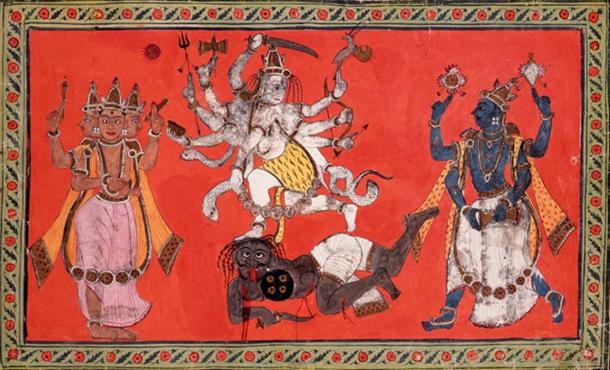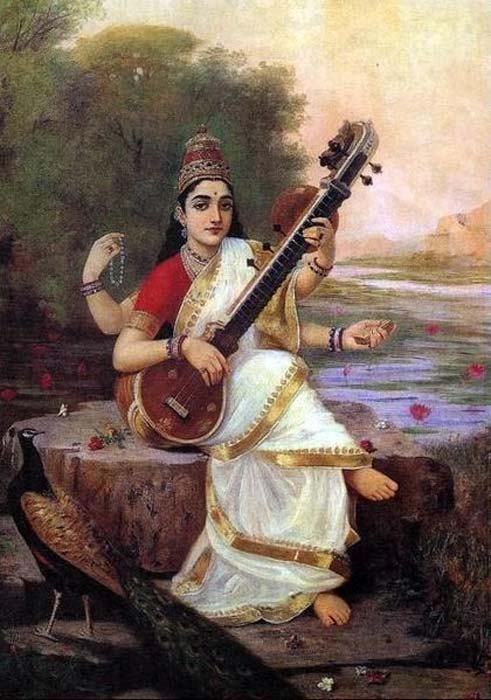Saraswati: Hindu Goddess of Aesthetics and Protector of the Universe

A deity with as many attributes as arms, Saraswati (or Sarasvati) is the Hindu goddess of aesthetics. These include music, the arts, wisdom and learning. She can be compared, in many ways, to the Greek god Apollo combined with the mental prowess of the Greek goddess Athena. She is wed to Brahma, the highest deity of the Hindu religion and complements his abstraction of the universe with her active efforts to seek and maintain the wisdom to protect it. But what exactly is her position in the Hindu hierarchy?
The Two Hindu Trinities
Saraswati is part of one of the two primary trinities in Hindu culture. The first, and better known, is that of Brahma, Vishnu and Shiva who together keep the cosmos in order. In the Hindu tradition, Brahma is responsible for creating the universe; Vishnu ensures the universe is maintained and ordered; while Shiva is tasked with destroying the universe at an allotted time and recycling/reviving it accordingly.
Saraswati is part of a second trinity together with Lakshmi and Parvati. Lakshmi is the wife of Vishnu and is associated with wealth and prosperity. Parvati is the goddess of love and fertility. With the wisdom and artistry of Saraswati, these three women aid in the maintenance of the cosmos alongside their male counterparts. Interestingly, there are some customs that portray Saraswati as a wife of Vishnu, possibly because Vishnu is more actively worshipped than Brahma and that she was later given to Brahma as a gift.

Shiva Performing the Dance of Bliss while Vishnu and Brahma Provide Musical Accompaniment (public domain)
A Pure Seeker of Knowledge
In art, Saraswati is associated with the white lotus flower, as it symbolized the knowledge which she is constantly seeking. She is often also associated with a swan or hamsa to identity with her pure, innocent nature—as it is believed wisdom is best achieved through indiscriminate means. She is portrayed in yellow or white, and her primary festival (Saraswati Puja) is celebrated on the first day of spring.

Lotus water flower
It is likely that, due to her pure nature and intellectual prowess, young children are taught the alphabet and preliminary learning skills during the Saraswati Puja. Saraswati's spring association is likely intended to represent the ever-changing progression of nature alongside the development of children and their knowledge. In other mythological literature regarding Saraswati, she is said to provide gifts of education and learning to other gods. For example, she provides Ganesha, the elephant companion of Shiva, with pen and ink.

Water worship
It was common to worship Saraswati in the modern day river Sarsuti, once named the Saraswati River. Just like the well-known Ganges River, the Sarsuti has long been thought to possess otherworldly powers. Bathing in it was believed to bring the worshipper good fortune and fertility. Whether Saraswati was a goddess prior to the naming of the river, or the river was personified into a goddess after years of worship there is uncertain. However, there is an agreement among scholars that this site is associated with the goddess.
Saraswati's name is first found in the Rigveda, one of four sacred texts of the Hindu religion. It dates back to around 1700-1100 BC, therefore indicating that Saraswati has long been a pertinent part of the evolving faith. A chapter of the Mahabharata, a Hindu epic, even claims that Saraswati herself was responsible for the creation of the Rigveda and its three counterparts: the Yajurveda, Samaveda and Atharvaveda. This is a sensible presumption based on Saraswati's various aspects of wisdom and the limitless knowledge of the universe.
Saraswati is also known by other names, each epithet indicative of the primary aspect of her person the worshiper wants to invoke. Some of these names are: Bharati, Shatarupa, and Vac - eloquence, existence and speech respectively.
It should also be noted that Saraswati has roles in other Asian religions, particularly Jainism and Buddhism. Her roles in these faiths are slightly different, though she remains predominately a goddess of knowledge.
J.KANNAN, M.Com, FIATA
"WE DON'T THINK TO BREATHE
WE BREATHE TO THINK"
No comments:
Post a Comment